“The real, native South Seas food is lousy. You can’t eat it.”
– Victor Jules Bergeron (Trader Vic)
Buenos Aires – Never having been to any of the eighteen islands and islets that make up Samoa, and that would fit, combined, comfortably into the state of Rhode Island, I’d be hard-pressed to even guess at what the “real, native” cuisine is actually like. My experience of food from any part of Polynesia, probably like many of us, comes from places that range from theme restaurants like a Trader Vic’s, to an occasional dish prepared by someone from there – most of which I had at various spots while traveling in Australia. There are certainly online and book references to the cuisine, though a good percentage of it appears to be very “adapted”, as opposed to something that has the air of tradition to it. So be it. As usual, we’re just out to have some fun and do something a bit different. And so, this last weekend found us offering up a Samoan inspired menu in celebration of Samoan Independence Day(s) – since it’s celebrated from June 1st through 3rd – this was, I gather, the 45th official celebration.
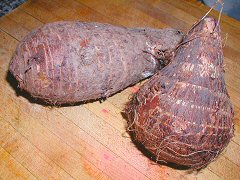 I find myself thinking, post-fact, that we probably should have offered something silly and tacky in the genre, like a mai-tai shot, as a welcome drink. I have to start thinking about stuff like that – I’ve been spending more and more of my time in the kitchen or in front of the computer, writing, and have begun to find that my thoughts don’t go automatically to the drinks end of things like they used to. I’ll post myself a note. It was actually fairly fascinating to spend some time reading about the cuisine – as best I could determine, the traditional dishes tend to involve an inordinate amount of taro – from the root to the leaves. Now, for those who don’t know taro, the most common part we tend to get to use is the root – it’s an oblong tuber, sometimes sort of pear shaped, with a bark-like exterior. Inside, the flesh is about the texture of an uncooked sweet potato – much firmer than a potato – and ranges in color from a creamy white to a vaguely purplish color – most often, however, being creamy white with purple speckles all through it. When cooked, the color of those speckles tends to spread out and turn the whole piece a light violet color. Locally, taro goes by a variety of names, most commonly either iñame or papañame – the only place I’ve encountered them is in chinatown. The other part used is the leaf, which isn’t, as best I can determine, available here – and spinach is a common substitute in places where the leaf isn’t available – I had to do the same thing, for a relative of taro, the dasheen, when we had our Saint Vincent and Grenadines dinner. One other note, and only true for some varieties of taro, the flesh exudes a sort of milky sap which is a skin irritant, and also poisonous to ingest, so when peeling these, you’re best off wearing rubber gloves, and then washing your knife and cutting board carefully. The venom is neutralized by heat, so taro is only consumed cooked, not raw.
I find myself thinking, post-fact, that we probably should have offered something silly and tacky in the genre, like a mai-tai shot, as a welcome drink. I have to start thinking about stuff like that – I’ve been spending more and more of my time in the kitchen or in front of the computer, writing, and have begun to find that my thoughts don’t go automatically to the drinks end of things like they used to. I’ll post myself a note. It was actually fairly fascinating to spend some time reading about the cuisine – as best I could determine, the traditional dishes tend to involve an inordinate amount of taro – from the root to the leaves. Now, for those who don’t know taro, the most common part we tend to get to use is the root – it’s an oblong tuber, sometimes sort of pear shaped, with a bark-like exterior. Inside, the flesh is about the texture of an uncooked sweet potato – much firmer than a potato – and ranges in color from a creamy white to a vaguely purplish color – most often, however, being creamy white with purple speckles all through it. When cooked, the color of those speckles tends to spread out and turn the whole piece a light violet color. Locally, taro goes by a variety of names, most commonly either iñame or papañame – the only place I’ve encountered them is in chinatown. The other part used is the leaf, which isn’t, as best I can determine, available here – and spinach is a common substitute in places where the leaf isn’t available – I had to do the same thing, for a relative of taro, the dasheen, when we had our Saint Vincent and Grenadines dinner. One other note, and only true for some varieties of taro, the flesh exudes a sort of milky sap which is a skin irritant, and also poisonous to ingest, so when peeling these, you’re best off wearing rubber gloves, and then washing your knife and cutting board carefully. The venom is neutralized by heat, so taro is only consumed cooked, not raw.
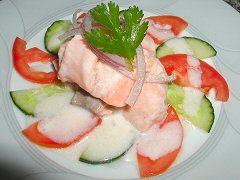 Various sources offered up recipes for either oka oka or oka i’a – I’m not sure of the difference, they seemed to be much the same, but there seemed to be some indication that the former is a more general name, and the latter perhaps referred to the use of a specific kind of fish, maybe a tuna relative. In essence, this dish is the Samoan equivalent of ceviche, the main differences being the addition of coconut milk to the marinating liquid and different accompaniments. Now, I was planning to use taro in a later dish, so I decided to simply leave it off of this one. Although I’m guessing that these are more adaptive elements for “western tastes”, several recipes suggested cucumbers and tomatoes be used along with the fish (I used salmon, as tuna is not in season here). Beyond that, it was a pretty straightforward ceviche – the salmon was marinated for about half an hour in a mix of lime juice and salt, then the coconut milk added just before serving, the dish was garnished with cucumbers, tomatoes, red onion (soaked for a little while in salt water to remove bitterness), hot peppers (rocotos), and cilantro. The coconut adds an interesting, and somewhat elusive note to the dish, though I’d be interested to find out what vegetables really are more traditional to pair with the fish – the cucumbers and tomatoes seemed, somehow, out of place.
Various sources offered up recipes for either oka oka or oka i’a – I’m not sure of the difference, they seemed to be much the same, but there seemed to be some indication that the former is a more general name, and the latter perhaps referred to the use of a specific kind of fish, maybe a tuna relative. In essence, this dish is the Samoan equivalent of ceviche, the main differences being the addition of coconut milk to the marinating liquid and different accompaniments. Now, I was planning to use taro in a later dish, so I decided to simply leave it off of this one. Although I’m guessing that these are more adaptive elements for “western tastes”, several recipes suggested cucumbers and tomatoes be used along with the fish (I used salmon, as tuna is not in season here). Beyond that, it was a pretty straightforward ceviche – the salmon was marinated for about half an hour in a mix of lime juice and salt, then the coconut milk added just before serving, the dish was garnished with cucumbers, tomatoes, red onion (soaked for a little while in salt water to remove bitterness), hot peppers (rocotos), and cilantro. The coconut adds an interesting, and somewhat elusive note to the dish, though I’d be interested to find out what vegetables really are more traditional to pair with the fish – the cucumbers and tomatoes seemed, somehow, out of place.
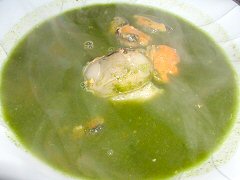 This was, I think, my favorite dish of the evening. But then I like soups a lot. I’ve actually been toying with the idea of creating a small restaurant totally revolving around different soups – Seinfeld’s “Soup Nazi” aside, I think it would go over well here, especially if we offered a good range of creative soups for takeout, delivery, and eating in. Of course, we’d have to have something to go with them – some good breads, perhaps some sandwiches… an idea in the works. The traditional soups that I saw seemed to be based on taro leaves, local herbs, and some sort of cured pork preperation, none of which are available here, but it gave me something to start with. I made a light roux – cooking flour in corn oil – roughly 1:2, I used ¼ cup of flour to ½ cup of oil – over medium low heat, stirring regularly, until the flour was lightly browned – about 30 minutes of cooking. Then I added finely chopped bacon, and continued cooking for another 30 minutes until the fat was rendered out and the bacon pieces were lightly browned. I added a large chopped white onion, and kept cooking until it was also lightly browned – about another 15 minutes. At that point, I topped the pot off with chicken stock and brought it to a boil. When boiling, I added a large quantity of fresh spinach leaves, and a good handful of tarragon leaves, and cooked them just until they wilted into the pot. Off the heat and into the blender in batches, pureeing it very fine. That was it for the soup base – a little salt and white pepper for seasoning. When ready to serve, I sauteed some fresh mussels and clams (shrimp might be a nice addition too), in a little butter, when just cooked, scooped them out into bowls and topped with a ladleful of the soup base.
This was, I think, my favorite dish of the evening. But then I like soups a lot. I’ve actually been toying with the idea of creating a small restaurant totally revolving around different soups – Seinfeld’s “Soup Nazi” aside, I think it would go over well here, especially if we offered a good range of creative soups for takeout, delivery, and eating in. Of course, we’d have to have something to go with them – some good breads, perhaps some sandwiches… an idea in the works. The traditional soups that I saw seemed to be based on taro leaves, local herbs, and some sort of cured pork preperation, none of which are available here, but it gave me something to start with. I made a light roux – cooking flour in corn oil – roughly 1:2, I used ¼ cup of flour to ½ cup of oil – over medium low heat, stirring regularly, until the flour was lightly browned – about 30 minutes of cooking. Then I added finely chopped bacon, and continued cooking for another 30 minutes until the fat was rendered out and the bacon pieces were lightly browned. I added a large chopped white onion, and kept cooking until it was also lightly browned – about another 15 minutes. At that point, I topped the pot off with chicken stock and brought it to a boil. When boiling, I added a large quantity of fresh spinach leaves, and a good handful of tarragon leaves, and cooked them just until they wilted into the pot. Off the heat and into the blender in batches, pureeing it very fine. That was it for the soup base – a little salt and white pepper for seasoning. When ready to serve, I sauteed some fresh mussels and clams (shrimp might be a nice addition too), in a little butter, when just cooked, scooped them out into bowls and topped with a ladleful of the soup base.
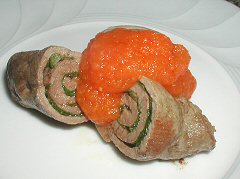 I knew that my main course was going to be a stir-fry, so, horror of horros, I decided to serve the beef before the chicken. How… wrong… apparently. No, really, no one seemed to notice or care, though Henry thought it was quite odd for the order of service. So this dish was based on a stir-fry dish, but I took out the components and made something different with it. First off, once again, no taro leaves, this time I used some fresh navisas, or turnip greens, which have just come into season. I cleaned and then blanched and shocked them to preserve their color. Then I rolled them up in thinly sliced lomo, or sirloin, seasoned simply with salt and pepper. Then I browned those on the outside in a sautepan, threw the pan in the oven and cooked them until they were about medium in the center. I took the other stir-fry ingredients and made them into a pureed sauce – papapya, onion, vinegar, honey, and a touch of hot pepper – and then brought it to a boil, let it cook to cook out the raw onion and pepper flavors, and then let it sit to meld the flavors… a minor mistake – having forgotten that papayas contain a huge amount of pectin, which, after being activated by the heat, simply gelled as the sauce cooled – and I ended up with a papaya and hot pepper jelly. Not a bad thing, it was pretty, and easily spoonable, but thicker than I’d been thinking of. The way around it would be to cook everything together except the papaya, cool them, blend them with the papaya, and then heat it up just before serving – that would leave a thinner, smoother sauce – although likely it would gel fairly quickly on the plate.
I knew that my main course was going to be a stir-fry, so, horror of horros, I decided to serve the beef before the chicken. How… wrong… apparently. No, really, no one seemed to notice or care, though Henry thought it was quite odd for the order of service. So this dish was based on a stir-fry dish, but I took out the components and made something different with it. First off, once again, no taro leaves, this time I used some fresh navisas, or turnip greens, which have just come into season. I cleaned and then blanched and shocked them to preserve their color. Then I rolled them up in thinly sliced lomo, or sirloin, seasoned simply with salt and pepper. Then I browned those on the outside in a sautepan, threw the pan in the oven and cooked them until they were about medium in the center. I took the other stir-fry ingredients and made them into a pureed sauce – papapya, onion, vinegar, honey, and a touch of hot pepper – and then brought it to a boil, let it cook to cook out the raw onion and pepper flavors, and then let it sit to meld the flavors… a minor mistake – having forgotten that papayas contain a huge amount of pectin, which, after being activated by the heat, simply gelled as the sauce cooled – and I ended up with a papaya and hot pepper jelly. Not a bad thing, it was pretty, and easily spoonable, but thicker than I’d been thinking of. The way around it would be to cook everything together except the papaya, cool them, blend them with the papaya, and then heat it up just before serving – that would leave a thinner, smoother sauce – although likely it would gel fairly quickly on the plate.
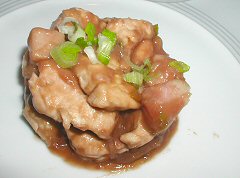 I already mentioned about preparing the taro roots – I diced them in about ½” dice, and then boiled them until cooked through, drained them and set them aside. I diced up a roughly equal volume of chicken breast and tossed it with some cornstarch and salt, chopped some fresh ginger and green onions. When ready to cook, I sauteed the ginger in a mix of oil and butter for a couple of minutes, added the chicken and cooked until lightly browned on the outside, then added the green onions and taro root, covered the pan, and let it cook, stirring occasionally, until cooked through. I made a mix of equal parts soy sauce and red wine, and a spoonful or two of sugar. When the chicken mixture was cooked, I added this liquid to the pan, stirring to coat thoroughly – the cornstarch that was coating the chicken will nearly immediately thicken the sauce. Salt and pepper for seasoning, some more chopped green onion for garnish, and serve.
I already mentioned about preparing the taro roots – I diced them in about ½” dice, and then boiled them until cooked through, drained them and set them aside. I diced up a roughly equal volume of chicken breast and tossed it with some cornstarch and salt, chopped some fresh ginger and green onions. When ready to cook, I sauteed the ginger in a mix of oil and butter for a couple of minutes, added the chicken and cooked until lightly browned on the outside, then added the green onions and taro root, covered the pan, and let it cook, stirring occasionally, until cooked through. I made a mix of equal parts soy sauce and red wine, and a spoonful or two of sugar. When the chicken mixture was cooked, I added this liquid to the pan, stirring to coat thoroughly – the cornstarch that was coating the chicken will nearly immediately thicken the sauce. Salt and pepper for seasoning, some more chopped green onion for garnish, and serve.
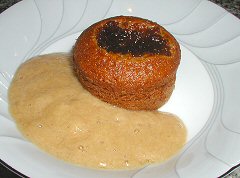 What to do for dessert? I couldn’t find anything out about traditional Samoan desserts, as best I could determine, it seems that fresh fruit is probably the most common sort of after meal sweet. So I picked a couple of things and decided just to play with them. First off, some kumquats, purely because they’re in season – I doubt they’re native to Samoa, but figured on them as a substitute for whatever citrus fruit is available there – I made a quick marmalade from them – coarsely chopping them in the blender or food processor, and then cooking them down with brown sugar (2:1 on volume) – until the seeds and peel are all softened through – about 35-40 minutes. I set that aside, but kept it hot – I’ll tell you why in a moment. I made a banana cake batter – simply mixing together two mashed bananas, 1½ cups sugar, ¼ cup of butter, 2 eggs, 1 teaspoon vanilla, 1 teaspoon salt, 1½ cups cake flour, 1 teaspoon baking soda, and ¼ cup milk – a recipe that I found online called something like Polynesian Banana Sheet Cake… minus some things like coconut and nuts. I divided that equally into ramekins that I’d previously buttered and floured, and then, spooned a heaping tablespoon of the hot marmalade into the center of each. Now, why hot? Because if it’s cold, the dollop of marmalade simply sinks to the bottom of the batter, disappears from sight, and also will stick to the ramekin on the bottom. If you leave the marmalade hot, it instantly lightly cooks the surface of the batter when it makes contact, sufficiently to keep it suspended above the batter, which lets the cake cook properly, and kind of looks cool when finished. Bake these in a 350°F oven until browned and cooked through. I served these with a simple puree of fresh pineapple and brown sugar. It may not have been traditional, but it sure was good….
What to do for dessert? I couldn’t find anything out about traditional Samoan desserts, as best I could determine, it seems that fresh fruit is probably the most common sort of after meal sweet. So I picked a couple of things and decided just to play with them. First off, some kumquats, purely because they’re in season – I doubt they’re native to Samoa, but figured on them as a substitute for whatever citrus fruit is available there – I made a quick marmalade from them – coarsely chopping them in the blender or food processor, and then cooking them down with brown sugar (2:1 on volume) – until the seeds and peel are all softened through – about 35-40 minutes. I set that aside, but kept it hot – I’ll tell you why in a moment. I made a banana cake batter – simply mixing together two mashed bananas, 1½ cups sugar, ¼ cup of butter, 2 eggs, 1 teaspoon vanilla, 1 teaspoon salt, 1½ cups cake flour, 1 teaspoon baking soda, and ¼ cup milk – a recipe that I found online called something like Polynesian Banana Sheet Cake… minus some things like coconut and nuts. I divided that equally into ramekins that I’d previously buttered and floured, and then, spooned a heaping tablespoon of the hot marmalade into the center of each. Now, why hot? Because if it’s cold, the dollop of marmalade simply sinks to the bottom of the batter, disappears from sight, and also will stick to the ramekin on the bottom. If you leave the marmalade hot, it instantly lightly cooks the surface of the batter when it makes contact, sufficiently to keep it suspended above the batter, which lets the cake cook properly, and kind of looks cool when finished. Bake these in a 350°F oven until browned and cooked through. I served these with a simple puree of fresh pineapple and brown sugar. It may not have been traditional, but it sure was good….
I thought I’d answer a couple of your questions about Samoan cuisine.
First, okaoka is an interjection often heard if someone is amazed. It’s similar to our expressions of, “Holy cow,” or “Wow,” though the meaning is different.
Oka i’a is soused fish. To ‘oka’ is to souse, and i’a is the general word for fish. Many fish can be made into oka, but a very common fish that is used is the atu, or bonito, which is a type of tuna. Many smaller reef fish are also used in oka, sometimes whole with only the innards removed.
You wondered what native vegetables would be found in oka. Samoa doesn’t have many native vegetables. Taro leaves as you know is the primary one. Limu, which is a type of seaweed is also eaten but I don’t know that it would be found in an oka. Oka traditionally would have been made using salt water and would have been eaten at sea or by the seashore. But once a variety of citrus fruits arrived on the islands with European contact, lime juice became the favored sousing agent. I’ve seen oka made with mayonnaise and soy sauce; I’ve heard Samoans talk of oka made with Tabasco sauce or other chili sauce equivalents. But lime, coconut milk, and cucumbers, onions, and tomatoes with the raw bonito is very popular. By comparison, oka is similar to the Hawaiian lomilomi salmon and preparation of oka has undoubtedly been influenced by the same via cultural diffusion.
Samoan desserts are subtle in their sweetness compared to more ‘Western’ desserts. Fa’ausi is made from taro root or green papaya and has somewhat caramelized coconut milk sauce. Taufolo is made from a particular variety of breadfruit and resembles a very stiff caramelized pudding. Both Fa’ausi and taufolo are delicious once a person has come to appreciate the subtlety of their respective flavors and textures.
I hope this information is helpful for any future Independence Day celebrations. Your menu, however, looks delicious and I’m sure it was a lot of fun to create.
Soifua (To life!),
Matapona
Thank you for a ton of great information! It’s amazing how people find their way to and from various blogs and help out across the globe. Much appreciated.
Wow, indeed, for the useful information in the first comment. I have to say, though, I think I’d find it pretty challenging to eat in Samoa. I’m sure I’d adjust quickly so taro would seem like a hamburger after a while. Where precisely did your inspiration for such a meal come from?
If you mean the inspiration for the theme, just random wandering various “today in history” sort of sites. If you mean the menu, I spent a couple of hours perusing internet sites that had recipes and information about Samoan cuisine, picked out what seemed to be the primary ingredients, combinations, etc., and worked it out from there, based on what’s available here.
what are some desserts and what are the recipes
Kimberly,
The food we prepared is covered in the post, including how to make them – I just don’t give detailed quantities on most recipes, because it isn’t the way I cook. If you’re looking for some other places to find Samoan recipes, I’d recommend just a google search for “samoan recipes” or something similar – I found quite a few sites with good information and detailed recipes.
[…] meaning a soup of fish cooked in coconut milk. We have here… coconut milk, green plantains, taro root, cassava root, bell peppers, cilantro, onion, rocoto (again, in place of habanero), garlic, salt, […]